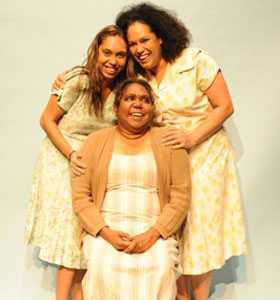Rainbow’s End | Riverside Theatre
- May 12th, 2011
- Posted in Reviews & Responses . Uncategorized
- Write comment

Last week, I had the great fortune to venture beyond the usual triumvirate of Stables, Belvoir and Wharf to visit areas of Sydney’s theatre landscape that I do not often frequent – Bankstown Arts Centre (Bankstown), Joan Sutherland Performing Arts Centre (Penrith) and Riverside theatres (Parramatta). This is not due to snobbery, or ignorance or lack of interest. It is largely to do with logistics of being a long term public transport devotee and being based in the inner west of Sydney. However, I thought it was really very interesting that three shows – each which represent and reveal important aspects of our identity, our past and our present by local artists – were so different in style and tone and story.
According to the programme notes, Jane Harrison’s Rainbow’s End was commissioned by Ilbijerri Theatre Company under a deadline of eight weeks and was consequently developed in rehearsal and production with Wesley Enoch in 2005. Since then, the play has been published by Currency Press and appears on the High School’s HSC syllabus. That production’s script has since been revisited for Riverside Theatre’s current production, directed by Craig Illot. I mention this only because I think it is an interesting example of how scripts are developed in Australia, how productions shape writing and how often directors can not only shape action on stage, but shape writing. It is indeed interesting to consider that the drafts and versions of Shakespeare’s scripts vary considerably, as Shakespearean scholars can attest, and interesting as well, that nothing has changed – and nor do I think it will – that plays are sometimes developed beyond the point of publication. I think that does take a certain amount of guts and a serious work ethic to not rest on a script – especially in the face of the marketability of the production to school groups. (And I sincerely hope that the dramaturgical work is noted and discussed in classrooms – the pros, the cons – the benefits, the drawbacks of viewing plays as living/adaptable art versus static literature).
Set in Victoria in the 1950s, the height of the Menzie’s era and the Queen’s visit to Australia – Rainbow’s End is a portrait of past, present and future visions of three generations of aboriginal women. As the blurb tells us –
“Three generations of Koori women, Nan Dear (Lillian Crombie) , her feisty daughter Gladys (Christine Anu) and Dolly (Chenoa Deemai), her clever teenage granddaughter live in a shack on a flood prone riverbank on the outskirts of a country town. For Nan, even life on ‘the Flats’ represents progress of a kind, but Gladys has bigger ambitions for a real house and a real job for Dolly. When Gladys takes on buying the Encyclopedia Britannica from city salesman Errol Fisher (Garth Holocombe) to improve Dolly’s chances, their lives take an unexpected and challenging turn.”
The portrait is full of issues and questions which still resonate – the value of independence in the face of familial duty, the importance of a sense of home and belonging, and the enduring power (and patience) of love. This story is one of personal transformation and elevation – as Gladys overcomes her illiteracy and her invisibility as an indigenous woman and learns to speak out against injustice and represent her people, Nan Dear overcomes her prejudice and cynicism towards her family’s status in society and Dolly overcomes physical violence and suffering in accepting the love of a man from a different background.
Complete with a beautiful set design by Jacob Nash and costumes by Rita Carmody, accompanying sound design by Jeremy Silver and Lighting Design by Matthew Marshall, this is a handsome production. Beautifully produced by Camilla Rountree and Riverside Theatre, Illot’s production weighs the political and social issues with the love story to great effect. Performances are impressive – especially that of Christine Anu who lights up the stage and is utterly mesmerizing as Gladys and Garth Holocombe who cycles (pardon the pun) artfully and with great charm through a myriad of male characters.
Unfortunately for Sydneysiders and Parramatta locals, I write this a few days too late for you to see this beautiful production, but fortunately has started on it’s national tour – but should it turn up (or return or be remounted) in your neck of the woods, I do recommend you take the time to enjoy the journey.